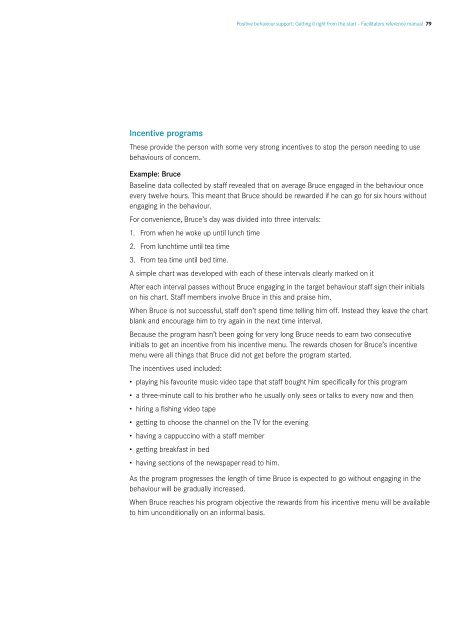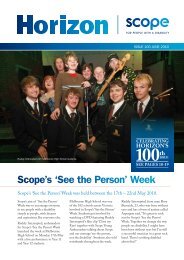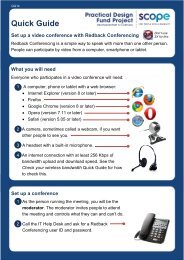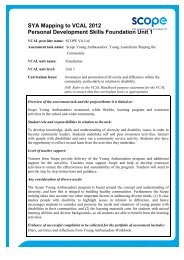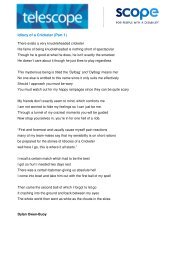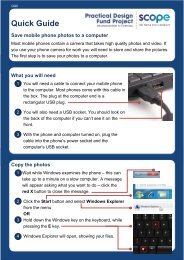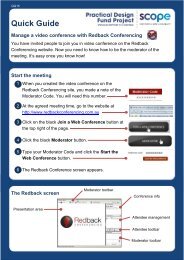Positive behaviour support Getting it right from the start
Positive behaviour support Getting it right from the start
Positive behaviour support Getting it right from the start
Create successful ePaper yourself
Turn your PDF publications into a flip-book with our unique Google optimized e-Paper software.
<strong>Pos<strong>it</strong>ive</strong> <strong>behaviour</strong> <strong>support</strong>: <strong>Getting</strong> <strong>it</strong> <strong>right</strong> <strong>from</strong> <strong>the</strong> <strong>start</strong> - Facil<strong>it</strong>ators reference manual 79<br />
Incentive programs<br />
These provide <strong>the</strong> person w<strong>it</strong>h some very strong incentives to stop <strong>the</strong> person needing to use<br />
<strong>behaviour</strong>s of concern.<br />
Example: Bruce<br />
Baseline data collected by staff revealed that on average Bruce engaged in <strong>the</strong> <strong>behaviour</strong> once<br />
every twelve hours. This meant that Bruce should be rewarded if he can go for six hours w<strong>it</strong>hout<br />
engaging in <strong>the</strong> <strong>behaviour</strong>.<br />
For convenience, Bruce’s day was divided into three intervals:<br />
1. From when he woke up until lunch time<br />
2. From lunchtime until tea time<br />
3. From tea time until bed time.<br />
A simple chart was developed w<strong>it</strong>h each of <strong>the</strong>se intervals clearly marked on <strong>it</strong><br />
After each interval passes w<strong>it</strong>hout Bruce engaging in <strong>the</strong> target <strong>behaviour</strong> staff sign <strong>the</strong>ir in<strong>it</strong>ials<br />
on his chart. Staff members involve Bruce in this and praise him.<br />
When Bruce is not successful, staff don’t spend time telling him off. Instead <strong>the</strong>y leave <strong>the</strong> chart<br />
blank and encourage him to try again in <strong>the</strong> next time interval.<br />
Because <strong>the</strong> program hasn’t been going for very long Bruce needs to earn two consecutive<br />
in<strong>it</strong>ials to get an incentive <strong>from</strong> his incentive menu. The rewards chosen for Bruce’s incentive<br />
menu were all things that Bruce did not get before <strong>the</strong> program <strong>start</strong>ed.<br />
The incentives used included:<br />
• playing his favour<strong>it</strong>e music video tape that staff bought him specifically for this program<br />
• a three-minute call to his bro<strong>the</strong>r who he usually only sees or talks to every now and <strong>the</strong>n<br />
• hiring a fishing video tape<br />
• getting to choose <strong>the</strong> channel on <strong>the</strong> TV for <strong>the</strong> evening<br />
• having a cappuccino w<strong>it</strong>h a staff member<br />
• getting breakfast in bed<br />
• having sections of <strong>the</strong> newspaper read to him.<br />
As <strong>the</strong> program progresses <strong>the</strong> length of time Bruce is expected to go w<strong>it</strong>hout engaging in <strong>the</strong><br />
<strong>behaviour</strong> will be gradually increased.<br />
When Bruce reaches his program objective <strong>the</strong> rewards <strong>from</strong> his incentive menu will be available<br />
to him uncond<strong>it</strong>ionally on an informal basis.


